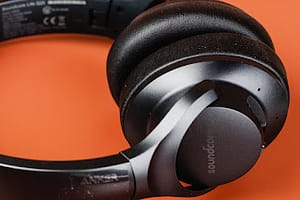
Active noise cancellation has become a significant trend in affordable consumer audio equipment in recent years.

Unfortunately, active noise cancellation (ANC) technology has recently been available only to professionals and wealthy audiophiles working with sound.
Still, it is often found even in budget models of headphones.
The leading electronics brands are constantly testing their headphones’ noise reduction, making the active noise reduction system a vital feature of all kinds of presentations. Meanwhile, this feature still needs to be fully understood by the average user.

After all, such a function is beneficial not only for music connoisseurs but also for fans of online casinos in India, who play club games in a noisy subway and want to protect themselves from loud sounds.

Why we need noise reduction in headphones
Noise reduction in headphones is used to eliminate or suppress external noise on a mechanical and software level so that the user is not distracted by irritants from calling, listening to music, or any other audio content.
Where does this come in handy? Just about anywhere, we encounter loud outside noise.
Walking down a busy street, in a crowded restaurant or bar, on public transport, in trains, subways, or planes, and even at home – say, while cleaning with a vacuum cleaner or next door with a neighbor who is in love with his drill.
That’s why these headphones with clear and high-quality sound have become a favorite choice for music lovers and anyone susceptible to external stimuli.
In this case, you can use the noise canceling function not only while talking or listening to your favorite playlist.
If you want to relax and enjoy the silence, the headphones with active noise canceling will be your salvation and a full-fledged replacement for the classic earplugs.
You can use them in this mode even during intensive work so you won’t be distracted by extraneous sounds.
However, active noise suppression has both pluses and minuses.
Let’s take an introductory look at how active noise cancellation works to understand whether you need headphones with ANC technology.
Principle of Active Noise Cancellation
So if there is a term “active noise reduction,” logically, there should be a passive one too?
Exactly right! Moreover, without passive noise cancellation, the ANC system could not work.
Passive noise cancellation in headphones has been used for decades, and you probably have experienced it if you have used earbuds with tight ear cushions or over-the-ear models with dense ear pads.
The principle behind passive noise isolation is simple: the design of the headphones blocks the ear canal so that only sound from the headphones, and not from the outside environment, enter it.
But this is ideal! In reality, more than the best quality passive noise cancellation is needed to eliminate the influence of external noise.
That’s where active noise cancellation comes in.
The technology of active noise cancellation enhances noise blocking by software methods.
It works in the following way. On the outer casing of the headphone is a microphone (or even a few), which captures all the sounds around the user.
The information it gathers is processed by the built-in microcomputer, which digitizes the resulting sound and broadcasts it through the speaker in an antiphase.
So put, additional sound waves are delivered to the user’s ear, which dampens the waves from all external noise.
The wave is superimposed on the wave, and as a result, the user hears neither car horns nor gusts of wind.
But again, this is ideal.
As a rule, even the technology of active noise cancellation can only partially overcome external noises: it is hampered by technological imperfections and various inaccuracies.
But to reduce them by dozens of decibels and provide the listener with much more comfort than modern consumer headphones can already do.
Moreover, such an advanced feature only affects the battery drain.
Active noise canceling is complicated, requiring modern and expensive components to manufacture headphones.
In addition to the external microphone, you need a fast microcomputer, which quickly processes the information and eliminates the delay.
After all, if the noise in the antiphase is broadcast too early or too late, it will only increase interference in music playback.
As far as microelectronics and software noise reduction methods are concerned, Apple remains the trendsetter with its clever second-generation AirPods Pro based on the innovative H2 processor.
But it should be noted that Samsung’s Galaxy Buds Pro, with their proprietary chips and ergonomic form factor, are slowly stepping on their heels and cost significantly less.
Benefits of active noise canceling headphones
We have already discussed the main advantage of headphones with active noise suppression – the ability to escape from loud external stimuli and calmly enjoy your favorite music, conversation, and silence.
It is worth highlighting some more advantages of headphones with the active noise cancellation function.
● First, technological advances have made active noise-canceling headphones more affordable than ever.
What a decade ago was a luxury only for the elite; today, you can buy much cheaper.
● Secondly, headphones with active cancellation functions are presented on the market in a wide variety.
The only necessary condition for implementing the ANC function is a passive noise cancellation system in at least some form.
And then the manufacturers can already refine themselves in many ways. What is a plus for users?
Such a range allows you to choose a model that will suit you personally quickly.
There are disadvantages too.
First of all, their increased cost is worth noting compared with more primitive models.
Even though ANC technology has become much more affordable in recent years, no one has yet canceled the increase in price due to the availability of advanced components.
It includes additional microphones for reading noise, a chip for processing and converting audio signals, and a high-quality emitter capable of accurately reproducing sound waves in the antiphase.
But there is a more severe problem. Some people cannot use active noise-canceling headphones because they give them headaches.
It is usually attributed to two factors.
The first is a low-quality chip that delivers sound waves in the antiphase through the speaker incorrectly or with too much delay.
It is easy enough to avoid if you buy reliable headphones with high-quality sound from trusted brands like the already mentioned Apple, Samsung, or Xiaomi.
But in some cases, even they can cause discomfort.
It usually happens to those prone to motion sickness or motion sickness.
In people with susceptible vestibular apparatus, active noise cancellation can cause pain that cannot be overcome.
If you have never used headphones with ANC technology, we recommend that you try them out before buying and make sure that it does not threaten you.
What is the result
Active noise-canceling headphones can become a real discovery for you and salvation from external sound stimuli in almost any life situation.
But it’s not worth it to overpay for them several times.
So, if you have never used the ANC function, look first at the budget models that will introduce you to this technology.
Advertise with the mоѕt vіѕіtеd nеwѕ ѕіtе іn Antigua!
We offer fully customizable and flexible digital marketing packages.
Contact us at [email protected]














